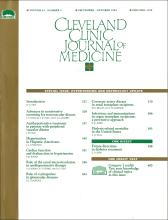ABSTRACT
BACKGROUND Infections after organ transplantation can be devastating in immunocompromised patients.
OBJECTIVE To review strategies for preventing infections after transplantation.
SUMMARY Immunization remains a cornerstone of preventive practice, but the suboptimal response to vaccinations in patients receiving immunosuppressive therapy presents an ongoing challenge. More work is needed to determine which of the numerous strategies for preventing symptomatic cytomegalovirus infection is most effective and economical, and under which circumstances. Prevention of Pneumocystis carinii pneumonia remains an important issue, especially in sulfa-intolerant patients. The relationship between different immunosuppressive programs and occurrence of infectious complications such as lymphoproliferative disease is just beginning to be understood. The toxicity of amphotericin B in this population has led to a search for more effective means of preventing and treating fungal infections. Finally, a new set of possible pathogens (such as the recently recognized human herpesvirus-6) is on the horizon.
CONCLUSIONS The best preventive approach encompasses awareness of epidemiologic risk, early detection of infection, appropriate prophylactic or preemptive therapy for specific infections, and close collaboration between the infectious-disease clinician and the transplant team.
- Copyright © 1994 The Cleveland Clinic Foundation. All Rights Reserved.






